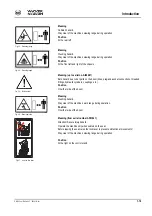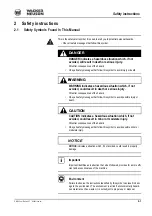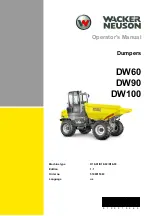
2-6
OM 803 us – Edition 3.7 * * 803b210us.fm
Safety instructions
Job site awareness
• Familiarize yourself with the surroundings and circumstances of the work site before
beginning work. Be aware of:
• obstacles in the working and traveling area
• the soil bearing capacity
• any necessary barriers separating the work site from public roads
• Always keep at a safe distance from the edges of building pits and slopes.
• Look out for the following when working in buildings or in enclosed areas:
• height of the ceiling/clearances
• width of entrances
• maximum load of ceilings and floors
• sufficient room ventilation – carbon monoxide poisoning hazard.
• Observe the danger zone. See “danger zone awareness“.
• Use the rearview mirror to stay aware of job site obstacles and personnel.
• Always use the work lights in conditions of poor visibility and after dark. However, make
sure that users of public roads will not be temporarily blinded by the work lights.
• Provide additional lighting of the job site if the lights of the machine are not sufficient for
performing work safely.
Danger zone awareness
• The danger zone is the area in which persons are in risk due to the movements of the
machine, work equipment, additional equipment or material.
• The danger zone also includes the area affected by falling material, equipment or
constructions debris. The danger zone must be extended by 0.5m (20 in) in the
immediate vicinity of buildings, scaffolds or other elements of construction.
• Seal off the danger zone if it is not possible to keep a safe distance. Stop work immedi-
ately if persons do not leave the danger zone.
Operating the machine
• Operate the machine ONLY when you are seated and you have fastened your seat
belt. Stop the engine before releasing the seat belt.
• During operation on slopes, move or work uphill or downhill. If traveling across a slope
cannot be avoided, bear in mind the tilting limit of the machine. Always keep the attach-
ments/work equipment close to the ground. This also applies to traveling downhill.
When traveling or working across a slope, the load must be on the uphill side of the
machine.
• On sloping terrain, ALWAYS adapt your travel speed to the prevailing ground condi-
tions.
• Never get on or off during machine operation or travel.
• The travel pedals require practice before an operator becomes familiar with the pedal
response. Therefore, adjust the travel speed to your abilities and the surroundings.
Carrying passengers
• Do not lift, lower or transport people on the machine or in the attachment.
• Never install a man basket or a working platform to the machine.






































